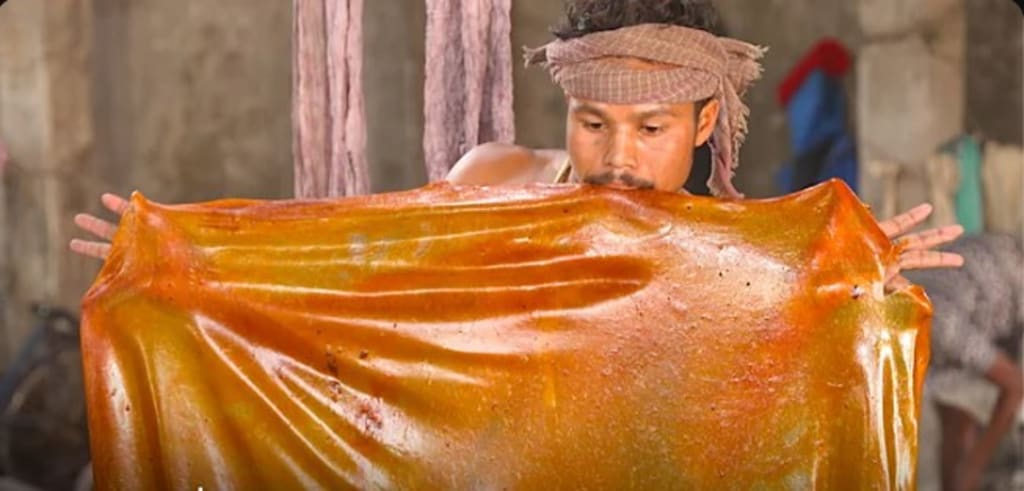Why Melted Bugs On Candy And Lemon Fuel A $167 Million Industry
Read To Know More About It

This Amber goop comes from Bugs and you've probably eaten it before .It's a natural resin called shellac and once it's stretched and cooled it's used in tons of ways formatting a shine to popular candies like jelly beans and preserving citrus fruit to finishing wood.
Its history dates back 3,000 years in India where it was originally used to make jewelry and Adorn palaces India is the world's largest shellac producer exporting over $65 Million worth of it a year but fluctuating harvests and prices have put this ancient industry at risk so how exactly do a tiny insects excretions end up on your candy and lemons .
We head to India to find out the kelaca insect is teeny barely big enough to see with the naked eye in June Farmers implant brood laac or the mama onto new tree branches their babies will hatch and spread out as they suck the tree sap the females secrete an amber colored resin when it hits the air it hardens creating a protective Nest this is what becomes valuable shellac this curve knife called a dow Le, is the most important tool for farmers like tlin Don she climbs up to 20 ft to reach the small branches where the insects grow she has about a hundred of these lack infested trees it can take as many as 300,000 insects to make just 1 kilo of shellac that's where the Lac insect derives its name from ich loock meaning 100,000 in Hindi.
Toin can harvest that in one day but it takes her two more to scrape it all off she uses the same DOI she sells the Lac to a local market earning $7 a kilo that's where Manoj sodi buys it his Factory sources raw lack from four states and processes over 500 metric tons a year it all starts with crushing and washing which is the most challenging part cleaning the lack for too long could lower the yield perf was then the lack has to dry to prevent mold and make it easier to extract the resin during Winters mono's staff leaves the lack in this yard for an hour and a half in hotter months it takes about half the time they have to watch it closely since too much heat can turn it black that's considered low quality and won't fetch as much money next the workers assign it one of four grades depending on the size they'll remove small sticks by hand this machine separates any in stones from the mix the workers put the Lac into a cloth tube that looks kind of like a giant sock they twist it so the mixture moves toward the Kiln and spin it until the Lac melts.
The stock collects any leftover rocks or sticks that might have snuck in they spend at least 6 hours a day spinning the tube and stoking the fire that burns at 167° F in the summer it can get up to 113°. In this factory, these symmetrical circles are called button shellac which are used to make Bangles. Workers also spread it across a tool called pipa to make sheet shellac they use a palm leaf to spread it out evenly. The workers remove it once it's cooled and they stretch it out even more using their hands feet and teeth this is how shellac has been made for centuries. They'll pull it to an even 5 by 5T Square these sheets will be used to polish candies cashew nuts and fruit .
Machines have largely replaced the traditional hand stretching method this one presses out thin sheets sort of like a pasta maker it processes most of the Factory's lack making shellac four times faster than by hand stretching the workers give it one quick tug and then rip it off .They'll hang it up to harden and cool and then chop it into hair thin pieces . These will stiffen into shards exported around the world Manoj can sell the refined shellac for almost double what he paid for it .
Indonesia and the United States are his biggest customers the US is also the world's largest importer buying up roughly a fourth of all Indian shellac it's been valued for 3,000 years for its versatility one of Shell's earliest uses was as a rich Crimson dye the insects excretions also made a strong glue and added a shiny water resistant finish to wood and leather in medieval Europe artists mixed it into Paints .
In the 1800s, it became the base of gramophone records before the invention of vinyl through the 1900s it was a popular finish for wood paneling in American Homes it also made its way into Pharmaceuticals coating pills and tablets and food as a glossy glaze for candies fruits cakes and nuts . Today the global shellac industry is worth over $167 million and more than half of the world Supply comes from India . The US Food and Drug Administration allows it as a food safe additive as long as it's listed on the ingredients list as shellac or confectioner glaze it's in treats like Junior jelly beans candy corn and Whoppers . It's also often dissolved in alcohol and sprayed onto citrus fruit. The waxy coating Wicks away moisture extending the fruit's shelf life and that gloss makes for a more eye-catching lemon on grocery store shelves .
Thousands of people in Toland's Village depend on shellac for a living but the price has fluctuated a lot in 2022 . Tolin could make $12 a kilo now the price is half that so she started farming ducks for additional income she also grows rice and vegetables that's because raising the storied insects has gotten a lot harder largely due to the climate crisis intensifying rainstorms have washed lack off tree branches and led to fungal infestations more extreme heat is drying up the trees that are the insects main food.
Food source V works for an NGO that helps farmers research ,why their insects are dying. His organization educates farmers on the benefits of using fungicides which can increase lack production armed with a little help from science . Indian Lac producers are fighting to keep raising their amber insects for generations to come.
About the Creator
Virgo Kanya
I've just started my career as a content writer. Hope to the support of my audience and see my efforts. Thank you to all who are reading my content.
Enjoyed the story? Support the Creator.
Subscribe for free to receive all their stories in your feed. You could also pledge your support or give them a one-off tip, letting them know you appreciate their work.






Comments
There are no comments for this story
Be the first to respond and start the conversation.